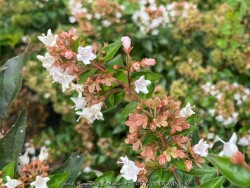

Raspberry Profusion Abelia (Abelia chinensis 'Raspberry Profusion') is a compact rounded, spreading, multi-stemmed shrub in the honeysuckle family. Typically grows on gracefully arching branches to 2-4' tall. 'Raspberry Profusion', a seedling selection of 'Edward Goucher' x chinensis, blooms heavily from May to September. The entire plant is covered with big clusters of strongly-scented, pink flowers with flamboyant raspberry sepals. The sepals remain after the flowers drop, extending the color until the end of autumn. New growth emerges glossy red and ages to a handsome dark green. The shrub is robust and compact, growing to 3-4' tall and wide. It is mostly deciduous in the winter. Semi-evergreen dark green leaves turn purplish-bronze in autumn persisting until 10 degrees F or so. Wood is hardy to 0 degrees F. In years where the stems die to the ground in winter but the plant survives, flowering will still occur on new growth. 'Raspberry Profusion' Abelia (Abelia chinensis 'Raspberry Profusion') is an unusually hardy abelia, thriving even in zone 5b. Abelia is also known for it's fragrant flowers that attract butterflies and hummingbirds, plus it's shade-tolerant and resistant to both deer and rabbits. Graceful, arching habit makes it a perfect choice for late season fragrance in your landscape.
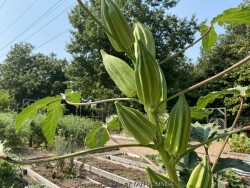

An Israeli variety, Star of David Okra (Abelmoschus esculentus 'Star of David') grows 6 to 10' tall. The plant produces giant 5- to 9-inch-long ornamental pods with medium spines if left to mature. Best picked about 3" long. Named because pod cross-sections look like the Star of David. Quite unusual and somewhat rare. Use as an edible garden plant or decorative annual. "Either pick 'em or leave 'em". 60 - 75 days to maturity.
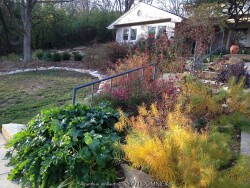

Bear's Breeches / Acanthus is a clump-forming perennial that is grown as much for its attractive dark green foliage as for its architecturally bold flower spikes. It is native to the Mediterranean region. Flowers are creamy white (sometimes pinkish) and snapdragon-like. Foliage is mostly evergreen in warm winter climates, but plants lose their leaves when winter temperatures dip below 20°F. Foliage is usually persisting until mid-early December in Kansas. If low temperatures hit -10 degrees F, it may kill an un-mulched plant; protect any zone 6 perennial with thick layer of mulch. Established plants survived -16 degrees F and a week of single digit highs in February, 2021. Acanthus may be grown a potted patio plant for full to part shade. Grown in a raised pot, they are hardy to about 15-20° so you may be able to miss the first few frosts when moving them in for the winter. Before extreme cold, overwinter in a dark garage or basement with monthly watering to encourage dormancy. Alternatively, it can maintain growing in a bright window as a houseplant. Either way, they will hold up very well in the winter and maintain their attractive foliage. In spring, just cut off dead foliage and place back out in April or May with a time-release fertilizer.
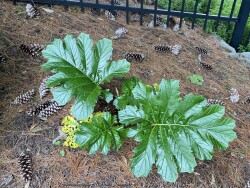

Bear's Breeches / Acanthus is a clump-forming perennial that is grown as much for its attractive dark green foliage as for its architecturally bold flower spikes. It is native to the Mediterranean region. Flowers are creamy white (sometimes pinkish) and snapdragon-like. Foliage is mostly evergreen in warm winter climates, but plants lose their leaves when winter temperatures dip below 20°F. Foliage is usually persisting until mid-early December in Kansas. If low temperatures hit -10 degrees F, it may kill an un-mulched plant; protect any zone 6 perennial with thick layer of mulch. Established plants survived -16 degrees F and a week of single digit highs in February, 2021. Acanthus may be grown a potted patio plant for full to part shade. Grown in a raised pot, they are hardy to about 15-20° so you may be able to miss the first few frosts when moving them in for the winter. Before extreme cold, overwinter in a dark garage or basement with monthly watering to encourage dormancy. Alternatively, it can maintain growing in a bright window as a houseplant. Either way, they will hold up very well in the winter and maintain their attractive foliage. In spring, just cut off dead foliage and place back out in April or May with a time-release fertilizer. Acanthus mollis 'Wofford Rhubarb' features beautiful red leaf stalks.
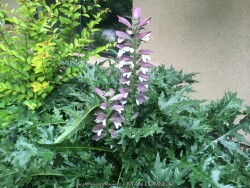

Spiny Bear's Breeches (Acanthus spinosus) is a clump-forming perennial that is grown as much for its attractive dark green foliage as for its architecturally bold flower spikes. The foliage of this species deeply cut and rather spiny looking dark-green leaves without actual spines. Flowers are creamy white (sometimes pinkish) and snapdragon-like and DO have sharp spines! It is the most thistly-looking of any of the various forms available. Foliage is mostly evergreen in warm winter climates, but plants lose their leaves when winter temperatures dip below 20°F. Foliage is usually persisting until mid-early December in Kansas. If low temperatures hit -10 degrees F, it may kill an un-mulched plant; protect any zone 6 perennial with thick layer of mulch. Established plants survived -16 degrees F and a week of single digit highs in February, 2021.
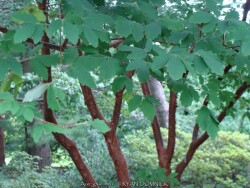

Paperbark maple (Acer griseum) is a small, deciduous, oval to oval-rounded tree with slender upright branching. It features exfoliating copper orange to cinnamon reddish/brown bark and showy orange to red fall color. Used in Kansas landscapes as an understory tree needing rich, moist soils. Even with ideal growing conditions, growth is slow.
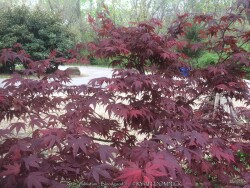

Bloodgood Japanese maple (Acer palmatum 'Bloodgood') is a small tree with gracefully branched stems and palmate red-purple leaves that turn bright red in the fall. Bloodgood has improved purplish maroon summer foliage color.Used in Kansas landscapes small lawn tree or understory tree in full to part shade needing rich, moist soils. Even with ideal growing conditions, growth is slow. Avoid afternoon sun in the heat of summer as leaf tips will burn. I have seen tremendous late spring freeze damage on rare occasions.


***Description comming later*** from Heritage Nursery "A fine cultivar distinguished by its bright red foliage. Whereas the more widely available cultivar, 'Bloodgood' has a maroon color, this one is redder, especially when the sun shines through the leaves. Leaves emerge two weeks later than 'Bloodgood'. Milwaukee, WI city arborists consider 'Emperor I' hardy within their urban area."


Oshio Beni Japanese maple (Acer palmatum 'Oshio Beni') is a small tree with gracefully branched stems and palmate red-purple leaves that turn bright red in the fall. Oshio Beni has improved purplish maroon summer foliage color and bright red-orange new growth in teh spring. Used in Kansas landscapes small lawn tree or understory tree in full to part shade needing rich, moist soils. Even with ideal growing conditions, growth is slow. Avoid afternoon sun in the heat of summer as leaf tips will burn. I have seen tremendous late spring freeze damage on rare occasions.
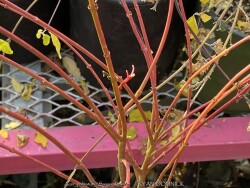

Sango Kaku Coral-twig Japanese Maple (Acer palmatum 'Sango Kaku') is a small tree with gracefully branched stems and palmate reddish-green leaves that turn bright red in the fall. Sango Kaku has amazing winter twig color that is a bright coral-red-orange color. Used in Kansas landscapes small lawn tree or understory tree in full to part shade needing rich, moist soils. Even with ideal growing conditions, growth is slow. Avoid afternoon sun in the heat of summer as leaf tips will burn. I have seen tremendous late spring freeze damage on rare occasions so cover if growth has started if the forcast calls for 28 degrees F or lower.


Japanese maple (Acer palmatum 'Atropurpureum') is a small tree with gracefully branched stems and palmate red-purple leaves that turn bright red in the fall. Used in Kansas landscapes small lawn tree or understory tree in full to part shade needing rich, moist soils. Even with ideal growing conditions, growth is slow. Avoid afternoon sun in the heat of summer as leaf tips will burn. I have seen tremendous late spring freeze damage on rare occasions.
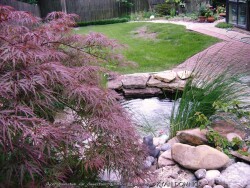

Crimson Laceleaf Japanese Maple (Acer palmatum var. dissectum 'Crimson Queen') is typically a much smaller, rounded, slow-growing shrubby form with deeply cut feathery leaves often with cascading branching. 'Crimson Queen' is a maroon red leaf variety. Used in Kansas landscapes as a specimen plant often near a waterfall or focal point. Needs full to part shade with rich, moist soils. Even with ideal growing conditions, growth is slow. Avoid afternoon sun in the heat of summer as leaf tips will burn. I have seen tremendous late spring freeze damage on rare occasions.


***Description comming later*** from Heritage Nursery "Among the best of the weeping red laceleaf maples, known for its leaf color retention in summer, its scorch resistance, vigor, and hardiness. Always popular and attractive."


***Description comming later*** from Heritage Nursery "This beautiful gem is more strongly weeping than most other selections of its kind. It goes through a kaleidoscope of reds, greens, and orange all season long."


***Description comming later*** from Heritage Nursery "Among the best of the weeping red laceleaf maples, known for its leaf color retention in summer, its scorch resistance, vigor, and hardiness. Always popular and attractive."


***Description comming later*** from Heritage Nursery "Among the best of the weeping red laceleaf maples, known for its leaf color retention in summer, its scorch resistance, vigor, and hardiness. Always popular and attractive."
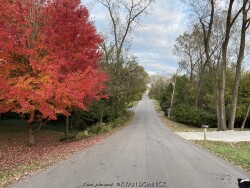

Red maple (Acer rubrum) is a large landscape tree common in Kansas and popular for its red to orange fall color and red spring flowers. While it does well in many soil types including wet compacted clays, it will struggle in an open exposed windy sites if drought stressed. Sun scald is another significant problem that can be prevented with protection or proper siting. The Red Maple has many claims to fame, including the greatest north-south range of any tree species living entirely in the eastern forests from Canada to southern Florida everglades. Its western native range is limited by lack of regular moisture, high pH soils, and intolerance to prairie wildfires.
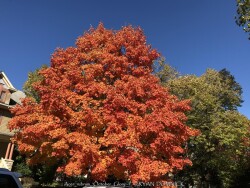

Red maple (Acer rubrum) is a large landscape tree common in Kansas and popular for its red to orange fall color and red spring flowers. While it does well in many soil types including wet compacted clays, it will struggle in an open exposed windy sites if drought stressed. Sun scald is another significant problem that can be prevented with protection or proper siting. The Red Maple has many claims to fame, including the greatest north-south range of any tree species living entirely in the eastern forests from Canada to southern Florida everglades. Its western native range is limited by lack of regular moisture, high pH soils, and intolerance to prairie wildfires. Acer rubrum 'October Glory' is noted for outstanding, reliable, bright orange to deep, reddish purple fall color - even in warmer climates. Foliage is also held on the tree later into fall than with most cultivars.
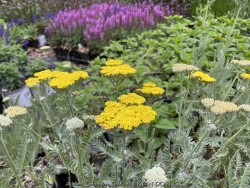

Coronation Gold Yarrow (Achillea 'Coronation Gold') is a vigorous tall growing yarrow with large golden-yellow flower heads. This non-reseeding variety blooms all summer and is considered to be one of the best yarrows for tolerating high humidity. It thrives when planted on a berm with heat and sun in poor soils including clay. Avoid rich soil, excessively windy sites, and too much irrigation.
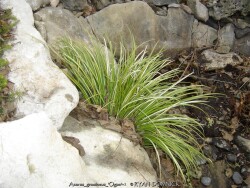

Golden Variegated Japanese Sweet Flag (Acorus gramineus 'Ogon') is a semi-evergreen marginal aquatic perennial. In constant wet conditions, it handles full-sun. It features a bright greenish-yellow grass-like tufts of narrow leaf blades. It is native to wetland areas of China, Japan, Korea, India, Thailand, Myanmar and the Philippines. In Kansas, it is very useful as a reliable rain garden plant or average garden plant in soils that do not dry out in full to part shade. Also useful on north walls and areas without tree-root competition. It cannot handle prolonged Kansas droughts or dry-shade. Foliage will flatten to the ground during brief drought then spring back up when moisture is available again. In Eastern Kansas, typically our 40 inches of rainfall is sufficient without extra water if planted in good soils. Generally however, in non-irrigated areas with poor soil, this plant will decline and allow weeds to invade. Foliage is evergreen (bright chartreuse-green) down to -5 to -10 degrees F offering valuable winter color.
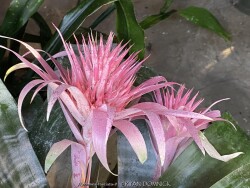

Silver Vase / Urn Plant (Aechmea fasciata) is an exotic-looking flowering plant from the bromeliad (Bromeliaceae) family. Despite its exotic appearance and tropical nature, this bromeliad adapts well to living as a potted house plant. In Kansas, use as a summer patio plant and protect from direct sunlight in mid summer and any temperatures below 50 degrees F in the spring or fall. As an epiphyte, much of its water needs are met by keeping the plants center "Urn" filled with water once per week or two. They have a shallow root systems and probably won't ever need repotted. When flowering, the flowers themselves are short-lived, but the pink and red bracts last for a few months.
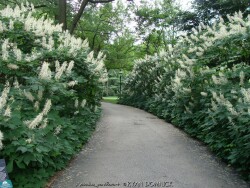

This species (Aesculus parviflora) grows as a large suckering deciduous shrub in evenly moist, well-drained soils in part shade to full shade. The species is native to the southeastern United States, where it is found primarily in Alabama and Georgia but is hardy much further North to zone 5. Useful in Kansas landscapes in rich established forest areas or along stream banks with plenty of room. Tends to thrive in rich forest soils of Eastern Kansas just fine without irrigation but is not known to tolerate moderate to drought. Bottlebrush buckeye features large palmate green leaves and tall cylindrical panicles (to 12" long) of tubular white flowers with conspicuous red anthers and pinkish filaments. Mid-summer bloom will not go unnoticed!
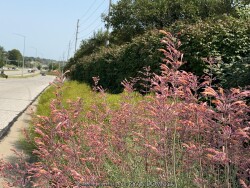

Sunset Agastache (Agastache rupestris) is a cold hardy, native hybrid perennial that blooms from mid to late summer and sporadically into the fall. This variety features a profusion of orange and pinkish flowers that attract hummingbirds and bumblebees. Both the flowers and foliage have a strong minty licorice scent when touched, and aromatic foliage helps to deter both deer and rabbits. Having desert heritage, it resents poor drainage and winter moisture. To counteract that in Kansas, plant in full sun on berm with poor sandy or rocky soil with no irrigation.
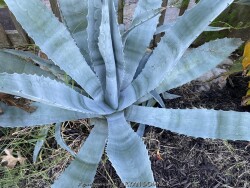

Powder Blue leaves from this agave (Agave americana) make an excellent architectural statement. Used as a patio plant in Kansas, place in full sun with no extra watering except from rainfall. Repotting may or may not be needed depending on how large you want the plant to grow. Potted plants are hardy to at least 20 degrees F if kept dry so you can wait awhile to move these in for the winter. Then move into a cold garage, basement, or window over the winter with NO watering. Luckily monocarpic flowering will never occur in a potted agave so you don't have to worry about death after flowering. A suggestion to make this plant a lot more safe around your eyeballs is to clip the new spines off as the new leaves slowly unfurl. As a winter-only house plant, it will look presentable all winter long with just no waterings. As a permanent house plant, provide bright light and allow the soil to dry between waterings for many years of carefree enjoyment.


Powder Blue leaves from this agave (Agave havardiana) make an excellent architectural statement. Used as a patio plant in Kansas, place in full sun with no extra watering except from rainfall. Repotting may or may not be needed depending on how large you want the plant to grow. Potted plants are hardy to at least 0-5 degrees F if kept dry so you can wait awhile to move these in for the winter. Then move into a cold garage, basement, or window over the winter with NO watering. Luckily monocarpic flowering will never occur in a potted agave so you don't have to worry about death after flowering. A suggestion to make this plant a lot more safe around your eyeballs is to clip the new spines off as the new leaves slowly unfurl. Although un-tested by the author, this agave could survive in a microclimate under a south facing roof overhang kept completely dry in the winter and controlled water in the summer. As a winter-only house plant, it will look presentable all winter long with just no waterings. As a permanent house plant, provide bright light and allow the soil to dry between waterings for many years of carefree enjoyment. We are testing this outside in our crevice garden among other hardy cacti and succulents! We will keep you posted. (2024)


Powder Blue leaves from this agave (Agave parryi var. couesii) make an excellent architectural statement. Used as a patio plant in Kansas, place in full sun with no extra watering except from rainfall. Repotting may or may not be needed depending on how large you want the plant to grow. Potted plants are hardy to at least 0-5 degrees F if kept dry so you can wait awhile to move these in for the winter. Then move into a cold garage, basement, or window over the winter with NO watering. Luckily monocarpic flowering will never occur in a potted agave so you don't have to worry about death after flowering. A suggestion to make this plant a lot more safe around your eyeballs is to clip the new spines off as the new leaves slowly unfurl. Although un-tested by the author, this agave could survive in a microclimate under a south facing roof overhang kept completely dry in the winter and controlled water in the summer. A planting in Stillwater Oklahoma has survived 20 years on an exposed sandstone retaining wall and endured temperatures as low as negative 19 F one winter and a week of negative night temperatures in 2021 with some foliage damage. As a winter-only house plant, it will look presentable all winter long with just no waterings. As a permanent house plant, provide bright light and allow the soil to dry between waterings for many years of carefree enjoyment. An large established potted plant in our Lawrence, KS (zone 6a) cold frame survived 0 degrees F for a couple days and lows in the single digits or teens for a week. It was kept dry but with no mulch or protection, accidentally being left on a raised greenhouse bench. It appeared frozen solid with a leaf breaking off and ice crystals visible! Amazingly, absolutely no damage occured when it thawed; must be filled with some kind of natural antifreeze or stretchy cell walls!
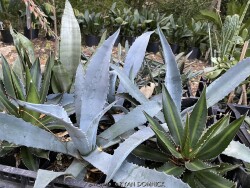

Powdery Blue leaves from agave make an excellent architectural statement. Used as a patio plant in Kansas, place in full sun with no extra watering except from rainfall. Repotting may or may not be needed depending on how large you want the plant to grow. Potted plants are hardy to at least 20 degrees F if kept dry so you can wait awhile to move these in for the winter. Then move into a cold garage, basement, or window over the winter with NO watering. Luckily monocarpic flowering will never occur in a potted agave so you don't have to worry about death after flowering. A suggestion to make this plant a lot more safe around your eyeballs is to clip the new spines off as the new leaves slowly unfurl. As a winter-only house plant, it will look presentable all winter long with just no waterings. As a permanent house plant, provide bright light and allow the soil to dry between waterings for many years of carefree enjoyment.
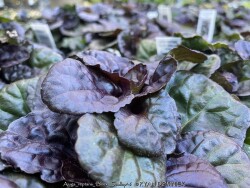

Ajugas are extremely hardy groundcovers that quickly form a dense carpet-like mat. Unlike many perennials that are grown only for their flowers, Ajuga is prized for its attractive, evergreen colorful foliage that looks nice all year. The deepest foliage color is achieved when plants are sited in full sun and in cooler temperatures although in Kansas this may result in foliage burning in summer if not adequately watered. From mid to late spring, short deep blue flower spikes stand upright above the foliage. Do not allow foliage to be covered with leaves or mulch during winter or crown rot disease may occur wiping out large patches. Ajuga reptans 'Black Scallop' tends to spread more slowly and stay naturally compact compared to other varieties of Ajuga, making it suitable for use as an edging, rock gardens, walking trails borders and mixed container plantings. This attractive small-scale variety has glossy, near-black, scalloped leaves and a dense habit.
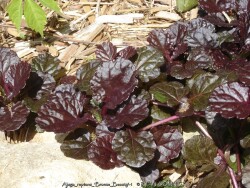

Ajugas are extremely hardy groundcovers that quickly form a dense carpet-like mat. Unlike many perennials that are grown only for their flowers, Ajuga is prized for its attractive, evergreen colorful foliage that looks nice all year. The deepest foliage color is achieved when plants are sited in full sun and in cooler temperatures although in Kansas this may result in foliage burning in summer if not adequately watered. From mid to late spring, short deep blue flower spikes stand upright above the foliage. Do not allow foliage to be covered with leaves or mulch during winter or crown rot disease may occur wiping out large patches. Ajuga reptans 'Bronze Beauty' tends to spread more slowly and stay naturally compact compared to other varieties of Ajuga, making it suitable for use as an edging, rock gardens, walking trails borders and mixed container plantings. This attractive small-scale variety has glossy, purplish-black, shiny leaves and a dense habit.


Five leaf Akebia (Akebia quinata) is a twining vine with green leaves arranged in a palmate shape. Maroon to purple flowers have the slight aroma of chocolate and bloom early in the spring. As with most vines, they are not low maintenance due to their nature and purpose in life. Vines by nature are kind of like freeloaders that want to use other things (and other plants) for free support. This does not directly parasitize the tree but can add a lot of weight (storm damage) and shade out it's foliage. It requires training to grow on some structures but will generally twine and try to grow to the highest point possible. When properly trained on a trellis or pergola, akebia can be amazing. It will grow in just about any soil and tolerate full shade to full sun. It may be used as a groundcover if nothing to climb on or an edible plant if you pollinate the flowers by hand. There are varieties available that when crossed, produce edible fruit. Akebia is invasive in some parts of the country but this is not the case in Kansas. Blooms occur in march or april very early when frosts are still occurring but with little damage to the plant. Foliage is persistent and semi evergreen until 10-15 degrees F.


Millenium Ornamental Onion (Allium 'Millenium') is among the best of the ornamental onions. This award-winning perennial produces a compact clump of glossy green leaves. Bright rosy purple, rounded flower clusters appear on strong stems just above the foliage. Unlike spring-blooming Allium bulbs, 'Millenium' blooms in mid-summer. The attractive, shiny deep-green grassy foliage is very ornamental and lasts all season including winter interest in Kansas. Grow in just about any soil including heavy clay in full to part sun. In Eastern Kansas, typically our 40 inches of rainfall is sufficient without extra water. And as with all alliums, these are completely rabbit proof. Considered a "Once it's there, it's there forever" plant!
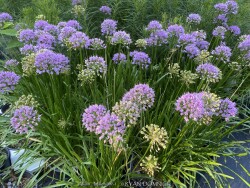

Millenium Ornamental Onion (Allium 'Millenium') is among the best of the ornamental onions. This award-winning perennial produces a compact clump of glossy green leaves. Bright rosy purple, rounded flower clusters appear on strong stems just above the foliage. Unlike spring-blooming Allium bulbs, 'Millenium' blooms in mid-summer. The attractive, shiny deep-green grassy foliage is very ornamental and lasts all season including winter interest in Kansas. Grow in just about any soil including heavy clay in full to part sun. In Eastern Kansas, typically our 40 inches of rainfall is sufficient without extra water. And as with all alliums, these are completely rabbit proof. Considered a "Once it's there, it's there forever" plant!


Serendipity Ornamental Onion (Allium 'Serendipity') is among the best of the ornamental onions. This award-winning perennial produces a compact clump of glossy blu-green leaves. Bright rosy purple, rounded flower clusters appear on strong stems just above the foliage. Unlike spring-blooming Allium bulbs, 'Serendipity' blooms in mid-summer. The attractive, shiny deep-green grassy foliage is very ornamental and lasts all season including winter interest in Kansas. Grow in just about any soil including heavy clay in full to part sun. In Eastern Kansas, typically our 40 inches of rainfall is sufficient without extra water. And as with all alliums, these are completely rabbit proof. Considered a "Once it's there, it's there forever" plant!
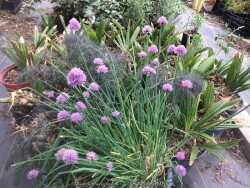

Chives (Allium schoenoprasum) are an easy to grow edible and ornamental perennial. Attractive, globular, clover-like clusters of pale purple flowers appear in spring and early summer. Grow in just about any soil including heavy clay in full to part sun. In Eastern Kansas, typically our 40 inches of rainfall is sufficient without extra water. And as with all alliums, these are completely rabbit proof. Considered a "Once it's there, it's there forever" plant!


***Description for this perennial available with future update!***


***Description for this plant available with future update!*** Cacti are known for their spines, unusual shapes and beautiful flowers. Both succulents and cacti store water in their fleshy tissues. And can survive long periods without water. Cacti and succulents are usually grown as a deck/patio plant or house plant in Kansas. Grow in full sun with little to no extra watering except that which comes from rainfall. Generally, plants may be brought out in Late May through Early October in our zone 6a Lawrence, KS climate. To play is safe, potted plants are best moved in before autumn leaves begin to drop and before night temperatures get below 45 degrees F. It is very important to avoid the combination of wet and cold. Move to a bright interior window over the winter with little to no watering and keep above 50 degrees F. As a winter house plant, it will look presentable all winter long with little to no waterings. As a permanent house plant, provide bright light and allow the soil to dry completely between waterings and you will get many years of carefree enjoyment. Plants grown permanently indoors may eventually begin to elongate stretching for light and lose their spine color. It can be hard to reproduce the intense UV sunlight they need when growing indoors so moving outside for the summer is best. Generally if moving outside for the summer, allow 1-2 weeks of part shade or morning sun before placing in full sun. Plants with time to acclimate will thrive in full sun but be careful not to rush it or sunburning may occur. Repotting may or may not be needed depending on how large you want the plant to grow; plants can continue to grow taller and tolerate extremely root-bound pots but may need wind bracing. If repotting, make sure to use a sharp draining low organic cactus mix with plenty of sand and perlite but avoid peat moss. The “soil” most commercial cacti are potted in to too peaty and light weight. This soil becomes hydrophobic and shrinks after becoming bone dry and difficult to re wet again. Cacti never grow in peat-based soils in nature; this “Soil” is only good for shipping because of the light weight. Potted plants are very low maintenance but watch for scale and mealybugs that may hide beneath the cover of spines. The best pest removal approach is to periodically wash the cactus off. Achieve this with a water nozzle or hose breaker turned mostly off to increase the pressure from the blast of water. This high-pressured water kills the pests without damaging the thick cactus skin. Here are some little-known or rare factoids about cacti: 1. The "spines" are actually modified leaves filled with sap at first, then quickly drying out to form the spines! 2. Many cacti have bright colored flowers that mainly attract bees, while some tubular flowering types attract hummingbirds and bats. 3. Late on the evolutionary timeline, cacti fossils are rare to non-existent. Cacti are native almost exclusively to the Americas, while succulents can include a much larger plant palette be from any dry area in the world. 4. Some cactus plants have been known to survive more than 2 years without water. 5. Some cacti first evolved in a dry climate that later became wetter again. For example: several jungle species live as epiphytes in trees to achieve the fast drainage they need.


***Description for this plant available with future update!*** Cacti are known for their spines, unusual shapes and beautiful flowers. Both succulents and cacti store water in their fleshy tissues. And can survive long periods without water. Cacti and succulents are usually grown as a deck/patio plant or house plant in Kansas. Grow in full sun with little to no extra watering except that which comes from rainfall. Generally, plants may be brought out in Late May through Early October in our zone 6a Lawrence, KS climate. To play is safe, potted plants are best moved in before autumn leaves begin to drop and before night temperatures get below 45 degrees F. It is very important to avoid the combination of wet and cold. Move to a bright interior window over the winter with little to no watering and keep above 50 degrees F. As a winter house plant, it will look presentable all winter long with little to no waterings. As a permanent house plant, provide bright light and allow the soil to dry completely between waterings and you will get many years of carefree enjoyment. Plants grown permanently indoors may eventually begin to elongate stretching for light and lose their spine color. It can be hard to reproduce the intense UV sunlight they need when growing indoors so moving outside for the summer is best. Generally if moving outside for the summer, allow 1-2 weeks of part shade or morning sun before placing in full sun. Plants with time to acclimate will thrive in full sun but be careful not to rush it or sunburning may occur. Repotting may or may not be needed depending on how large you want the plant to grow; plants can continue to grow taller and tolerate extremely root-bound pots but may need wind bracing. If repotting, make sure to use a sharp draining low organic cactus mix with plenty of sand and perlite but avoid peat moss. The “soil” most commercial cacti are potted in to too peaty and light weight. This soil becomes hydrophobic and shrinks after becoming bone dry and difficult to re wet again. Cacti never grow in peat-based soils in nature; this “Soil” is only good for shipping because of the light weight. Potted plants are very low maintenance but watch for scale and mealybugs that may hide beneath the cover of spines. The best pest removal approach is to periodically wash the cactus off. Achieve this with a water nozzle or hose breaker turned mostly off to increase the pressure from the blast of water. This high-pressured water kills the pests without damaging the thick cactus skin. Here are some little-known or rare factoids about cacti: 1. The "spines" are actually modified leaves filled with sap at first, then quickly drying out to form the spines! 2. Many cacti have bright colored flowers that mainly attract bees, while some tubular flowering types attract hummingbirds and bats. 3. Late on the evolutionary timeline, cacti fossils are rare to non-existent. Cacti are native almost exclusively to the Americas, while succulents can include a much larger plant palette be from any dry area in the world. 4. Some cactus plants have been known to survive more than 2 years without water. 5. Some cacti first evolved in a dry climate that later became wetter again. For example: several jungle species live as epiphytes in trees to achieve the fast drainage they need.


***Description for this hardy tropical available with future update!*** >>>>> Plant delights nursery says "Alstroemeria 'Indian Summer' is a breeding breakthrough in garden quality alstroemerias. This amazing selection has sailed through both our trials for heat and humidity as well as winter hardiness trials in western Michigan (multiple winters of below -15 degrees F). Alstroemeria 'Indian Summer' emerges in spring with 3' tall purple-tinted stalks, clothed with grey purple foliage, and topped, starting in late spring, with terminal clusters of flowers. The flowers are composed of three orange petals, intermixed with three yellow petals with violet flecks. Flowering slows in the heat or summer, but resumes as night temperatures cool, and continues until frost. The effect of Alstroemeria 'Indian Summer' in the garden is truly stunning!"
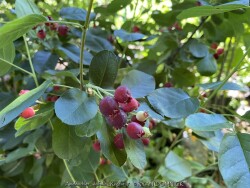

This serviceberry (Amelanchier alnifolia 'Regent') is a shrub to dwarf tree form with edible bluish-purple berry-like fruit, native to North America from Alaska across most of western Canada and in the western and north-central United States. Although it is adaptable to a variety of soil and moisture conditions, it shows some drought intolerance so go with sand plums on a drier site. The delicious fruit of this and related species are eaten fresh or prepared in puddings and pies. You need to act quick before the birds strip them clean. 'Regent' is a compact, deciduous, stoloniferous, early-flowering cultivar which typically grows only 4-6' tall. Great plant for the edible landscape!
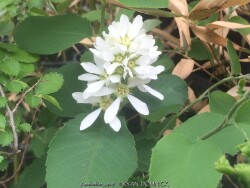

This serviceberry (Amelanchier canadensis) is a deciduous, early-flowering, large shrub or small tree which typically grows 15-25' tall with edible red to bluish-purple berry-like fruit. Native to Eastern North America. Although it is adaptable to a variety of soil and moisture conditions, it shows some drought intolerance so go with sand plums or American plums on a drier site. The delicious fruit of this and related species are eaten fresh or prepared in puddings and pies. You need to act quick before the birds strip them clean. Amelanchier canadensis is also called Shadblow Serviceberry. Great plant for the edible landscape!
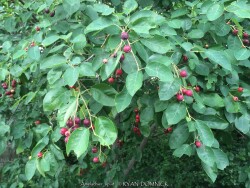

Serviceberry (Amelanchier sp.) can be a shrub or dwarf tree form with edible red to bluish-purple berry-like fruit, native to North America from Alaska across most of western Canada and in the western and north-central United States. Although it is adaptable to a variety of soil and moisture conditions, it shows some drought intolerance so go with sand plums on a drier site. The delicious fruit of this and related species are eaten fresh or prepared in puddings and pies. You need to act quick before the birds strip them clean. Great plant for the edible landscape!


This serviceberry (Amelanchier x grandiflora 'Autumn Brilliance') is a deciduous, early-flowering, large shrub or small tree which typically grows 15-25' tall with edible red to bluish-purple berry-like fruit. Native to Eastern North America. Although it is adaptable to a variety of soil and moisture conditions, it shows some drought intolerance so go with sand plums or American plums on a drier site. The delicious fruit of this and related species are eaten fresh or prepared in puddings and pies. You need to act quick before the birds strip them clean. Amelanchier x grandiflora is a hybrid cross between two species of North American serviceberry, namely, A. arborea (downy serviceberry) and A. laevis (Allegheny serviceberry). 'Autumn Brilliance' has brilliant orange-red fall color. Great plant for the edible landscape!
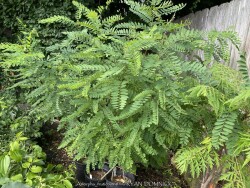

False Indigo Shrub (Amorpha fruticosa) is a 6-10 ft., loose, airy shrub which often forms dense thickets. The blooming season is relatively short but the pinnately compound leaves offers lasting interest and a "Wow" factor. The foliage is pinnately compound, fine-textured, and turns gold in the fall lasting for a week or two. Older plantings may be rejuvenated as they do develop a leggy character with the majority of their foliage on the upper third of the plant. This is a species of flowering plant in the legume family Fabaceae so it is able to make its own nitrogen. False Indigo Shrub tolerates many types of soil including wet sandy soils. Other names include desert false indigo, false indigo-bush, and bastard indigobush. It is native to North America and has potential to be invasive in parts of the country but not so much in Kansas.


***Description for this hardy tropical available with future update!***>>>>> Plant Delights Nursery says "This little-known but easy-to-grow voodoo lily is native to the Yunnan Province of China. The stalks are either solid green or green with grey spots and are each topped with a glossy green leaf. Amorphophallus albus is a fast offsetting species that forms a nice 2' wide patch (in 5 years) in the woodland garden. In spring, just as the leaf emerges, a 1' tall flower stalk appears alongside it with a 6-8" tall flower perched on top. Each flower resembles a large ivory shell showcasing a white, cigar-like appendage...green at the tip and white at the base." >>>>>>>>>> Voodoo (Amorphophallus konjac) lily is a perennial tuber generally grown as a curiosity for its interesting foliage. The single leaf consists of a stalk (petiole) with mottled pinkish-gray and olive green coloration. The single intricate leaf has horizontal sections giving it a tropical umbrella-like effect. Larger tubers (about the size of a grapefruit or larger) may produce a single "flower" in spring before the foliage appears. The "flower" is actually a large shiny purple to maroon ruffled spathe. When in bloom it produces an odor like a dead animal for 1 day. This is intended to attract the carrion flies that are its natural pollinators. It is possible to overwinter these in the ground in Kansas by placing a 6-12" mound of mulch over deeply planted tubers. New growth will usually be delayed until June but quickly regains full height and will get bigger each year; buried tubers are hardy to zone 6a. They can also be grown as a flowering summer patio plant. If growing as a potted plant and trying to overwinter, allowing the foliage to frost is ok, it will not kill the root system. However, do not allow the pot with rootball to freeze solid or go below 20 degrees for more than a few hours; move into a cold garage or basement over the winter with no watering. Cut back and allow to go dormant and place entire pot back out in April or May with a time-release fertilizer. Plants can get huge and exotic looking as a potted patio plant. Grown in Japan and Korea as an edible corm. Testing in Lawrence KS display gardens has been successful; surviving temperatures of -11F (2024)
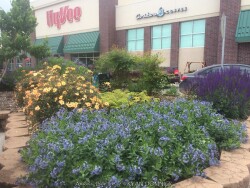

Blue Ice Amsonia (Amsonia 'Blue Ice') is a chance seedling from A. tabernaemontana which is native to North America. It bears gorgeous deep blue buds in late spring opening to vivid a periwinkle blue for about 4-6 weeks. The bright green foliage is compact and mostly pest-free. However in some years with high humidity and extra summer rainfall, the foliage gets diseased and should be cut back early. If in good air circulation, the foliage often turns a rich shade of yellow in fall characteristic of most amsonias. In Kansas Landscapes, it is usually planted as a mass groundcover growing into a dense weed proof mass. Established plants are low maintenance and almost never need to be replaced, divided or watered.


The species bluestar (Amsonia) grows up to 3 feet tall and prefers a medium to moist soil, but will tolerate a range of soils in light shade, including clay. "Once it's there, it's there forever" plant! Native to East-central U.S. in open woodlands and sunny plains. 'Storm Cloud' is and improved selection with new stems emerge near-black with leaves that are very dark green with silver veins. The stems stay dark throughout spring contrasting the light periwinkle blue, star-shaped flowers that completely cover the foliage by late spring. Some reblooming may occur for many weeks afterward. Although the main interest of this plant is in spring, it maintains a great garden presence throughout the summer and fall. Its wide, mounded habit lends itself well to be used in place of shrubs in the landscape. In some years with high humidity and extra summer rainfall, the foliage gets diseased and should be cut back early. Provide planting location with good air circulation to avoid this small problem. Compared to 'Storm Cloud', Amsonia 'Starstruck', a more compact version at 18", has wider leaves, and blooms about 1-2 weeks later in the spring. All Proven Winners® plants are legally propagated, healthy and vigorous, true to name, and tagged with color pictures and growing information.
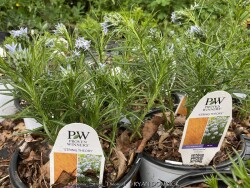

Narrow-leaf Amsonia (Amsonia hubrichtii) is clump-forming plant that is primarily grown in cultivation for its feathery green summer foliage and golden fall color. Spring flowers are powdery blue rising on 3' stalks creating a compact dense willow-like bush. The blooming season is relatively short but the pinnately compound leaves offers lasting interest and a "Wow" factor. Rich golden fall color is long-lasting and dries remaining attractive deep into the winter. No deadheading is needed and the only maintenance is cutting the plant back each winter after the fall foliage is no longer attractive. In some years with high humidity and extra summer rainfall, the foliage gets diseased and should be cut back early. Provide planting location in full sun with good air circulation to avoid this small problem. The growth is so dense that no weeds have a chance of invading a mature stand of plants. Amsonia hubrichtii is relatively new to cultivation being discovered in Arkansas in 1942 but is hardy in zones 5-9. Combine with other summer or fall flowering plants like hardy hibiscus, crapemyrtle, or penstemon. Fine-textured foliage also combines well with dark foliage, larger leaves, and dark colored walls! Great for large-scale mass plantings needing something permanent. This is a true four-seasons long-lived perennial that belongs in almost every perennial garden. String Theory Narrow-leaf Amsonia (Amsonia 'String Theory') can be described as a compact version of the industry standard Amsonia hubrichtii. All Proven Winners® plants are legally propagated, healthy and vigorous, true to name, and tagged with color pictures and growing information.
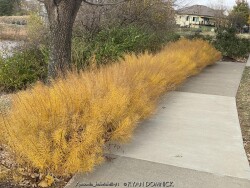

Narrow-leaf Amsonia (Amsonia hubrichtii) is clump-forming plant that is primarily grown in cultivation for its feathery green summer foliage and golden fall color. Spring flowers are powdery blue rising on 3' stalks creating a compact dense willow-like bush. The blooming season is relatively short but the pinnately compound leaves offers lasting interest and a "Wow" factor. Rich golden fall color is long-lasting and dries remaining attractive deep into the winter. No deadheading is needed and the only maintenance is cutting the plant back each winter after the fall foliage is no longer attractive. In some years with high humidity and extra summer rainfall, the foliage gets diseased and should be cut back early. Provide planting location in full sun with good air circulation to avoid this small problem. The growth is so dense that no weeds have a chance of invading a mature stand of plants. Amsonia hubrichtii is relatively new to cultivation being discovered in Arkansas in 1942 but is hardy in zones 5-9. Combine with other summer or fall flowering plants like hardy hibiscus, crapemyrtle, or penstemon. Fine-textured foliage also combines well with dark foliage, larger leaves, and dark colored walls! Great for large-scale mass plantings needing something permanent. This is a true four-seasons long-lived perennial that belongs in almost every perennial garden.
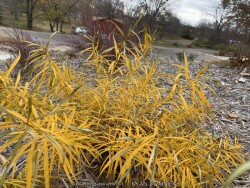

Narrow-leaf Amsonia (Amsonia hubrichtii) is clump-forming plant that is primarily grown in cultivation for its feathery green summer foliage and golden fall color. Spring flowers are powdery blue rising on 3' stalks creating a compact dense willow-like bush. The blooming season is relatively short but the pinnately compound leaves offers lasting interest and a "Wow" factor. Rich golden fall color is long-lasting and dries remaining attractive deep into the winter. No deadheading is needed and the only maintenance is cutting the plant back each winter after the fall foliage is no longer attractive. In some years with high humidity and extra summer rainfall, the foliage gets diseased and should be cut back early. Provide planting location in full sun with good air circulation to avoid this small problem. The growth is so dense that no weeds have a chance of invading a mature stand of plants. Amsonia hubrichtii is relatively new to cultivation being discovered in Arkansas in 1942 but is hardy in zones 5-9. Combine with other summer or fall flowering plants like hardy hibiscus, crapemyrtle, or penstemon. Fine-textured foliage also combines well with dark foliage, larger leaves, and dark colored walls! Great for large-scale mass plantings needing something permanent. This is a true four-seasons long-lived perennial that belongs in almost every perennial garden. Butterscotch Amsonia (Amsonia hubrichtii 'Butterscotch') is like other Amsonia in general appearance, but with improved form, reddish stems, superior rich "butterscotch" fall color, and great resistance to tip dieback. Flower color is also slightly darker blue.


Shining bluestar (Amsonia illustris) grows up to 3 feet tall and prefers a medium to moist soil, but will tolerate a range of soils in light shade, including clay. "Once it's there, it's there forever" plant! Native to Central U.S. most frequently occuring in sandy or rocky soils on gravel bars or along streams. Because it tolerates periods of brief flooding, it is an ideal amsonia for the rain-garden. This is a great amsonia for foliage quality, bearing Narrow, willow-shaped, leathery, shiny green leaves.